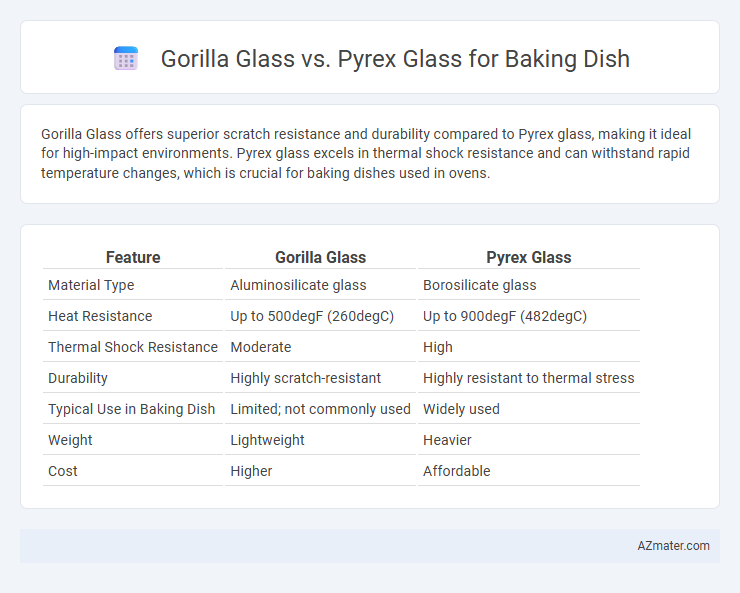Gorilla Glass offers superior scratch resistance and durability compared to Pyrex glass, making it ideal for high-impact environments. Pyrex glass excels in thermal shock resistance and can withstand rapid temperature changes, which is crucial for baking dishes used in ovens.
Table of Comparison
| Feature | Gorilla Glass | Pyrex Glass |
|---|---|---|
| Material Type | Aluminosilicate glass | Borosilicate glass |
| Heat Resistance | Up to 500degF (260degC) | Up to 900degF (482degC) |
| Thermal Shock Resistance | Moderate | High |
| Durability | Highly scratch-resistant | Highly resistant to thermal stress |
| Typical Use in Baking Dish | Limited; not commonly used | Widely used |
| Weight | Lightweight | Heavier |
| Cost | Higher | Affordable |
Introduction to Gorilla Glass and Pyrex Glass
Gorilla Glass, a chemically strengthened alkali-aluminosilicate glass, offers exceptional scratch resistance and durability, originally designed for electronic device screens but increasingly used in kitchenware for its lightweight and impact resistance. Pyrex glass, a borosilicate glass known for its thermal shock resistance and ability to withstand high oven temperatures, has been a trusted material for baking dishes due to its stability and non-reactive surface. Both materials provide distinct advantages: Gorilla Glass excels in toughness and shatter resistance, while Pyrex remains superior for rapid temperature changes in baking applications.
Composition and Manufacturing Differences
Gorilla Glass is made from an alkali-aluminosilicate composition, chemically strengthened through an ion-exchange process that replaces smaller ions with larger ones to enhance durability and scratch resistance. Pyrex glass, traditionally composed of borosilicate, features a low thermal expansion coefficient that allows superior resistance to thermal shock, manufactured through controlled melting and annealing processes. These fundamental differences result in Gorilla Glass being optimized for impact and scratch performance in thin, flat applications, while Pyrex excels in withstanding rapid temperature changes, making it ideal for baking dishes.
Heat Resistance Capabilities
Gorilla Glass, engineered primarily for electronic device screens, offers moderate heat resistance but is not designed for direct exposure to high baking temperatures, typically tolerating up to around 300degC (572degF). Pyrex glass, made from borosilicate or tempered soda-lime glass, provides superior thermal shock resistance and can withstand oven temperatures up to approximately 450degC (842degF), making it ideal for baking dishes. The enhanced heat resistance and durability of Pyrex glass ensure safer and more reliable performance during intense baking conditions compared to Gorilla Glass.
Durability and Strength Comparison
Gorilla Glass offers superior durability and scratch resistance due to its chemically strengthened alkali-aluminosilicate composition, making it highly resistant to impacts and drops compared to Pyrex glass. Pyrex, typically made from borosilicate or tempered soda-lime glass, provides excellent thermal shock resistance but is more prone to surface scratches and chips under mechanical stress. For baking dishes, Gorilla Glass ensures enhanced longevity and toughness, while Pyrex excels in heat tolerance but requires careful handling to avoid breakage.
Thermal Shock Resistance
Gorilla Glass exhibits superior thermal shock resistance compared to Pyrex glass, making it highly durable under rapid temperature changes commonly encountered in baking. Pyrex, traditionally made from borosilicate glass, offers good thermal shock resistance but is less resistant to sudden temperature shifts than chemically strengthened Gorilla Glass. The enhanced strength and toughness of Gorilla Glass reduce the risk of cracking or shattering when transferring dishes from oven to countertop or fridge.
Safety Under High Temperatures
Gorilla Glass offers exceptional scratch resistance and durability but is primarily designed for electronic screens, making it less suitable for extreme thermal cycling in baking applications. Pyrex glass, especially borosilicate variants, is engineered to withstand rapid temperature changes and high oven temperatures up to 450degF (232degC), ensuring safety and reducing the risk of thermal shock. For baking dishes, Pyrex glass remains the preferred choice due to its proven stability and safety under sustained high-heat conditions.
Scratch and Stain Resistance
Gorilla Glass exhibits superior scratch resistance compared to Pyrex glass, making it highly durable for baking dishes that undergo frequent use and cleaning. Pyrex glass, while resistant to staining, is more prone to surface scratches which can harbor stains and reduce clarity over time. The enhanced chemical composition of Gorilla Glass provides both high scratch and stain resistance, ensuring long-lasting clarity and performance in baking applications.
Weight and Handling in the Kitchen
Gorilla Glass is significantly lighter than Pyrex glass, making it easier to handle and maneuver in the kitchen, especially when transferring dishes in and out of the oven. Pyrex glass is thicker and heavier, which provides durability but can make lifting and washing more cumbersome. The lightweight nature of Gorilla Glass enhances user comfort and reduces strain during food preparation and cleanup.
Cost Analysis and Availability
Gorilla Glass, typically used in electronics, is less common and significantly more expensive for baking dishes compared to Pyrex glass, which is widely available and affordable due to its established market presence in kitchenware. Pyrex glass offers easier accessibility through numerous retail and online channels, while Gorilla Glass products for cooking are limited, driving up cost and reducing availability. Cost analysis shows Pyrex as a cost-effective solution with greater supply, making it the preferred choice for most consumers seeking durable baking dishes.
Conclusion: Best Choice for Baking Dishes
Gorilla Glass, known for its exceptional scratch resistance and strength, is primarily designed for electronic screens rather than high-temperature cooking applications. Pyrex glass, made from borosilicate or tempered soda-lime glass, offers superior thermal shock resistance and durability, making it ideal for baking dishes exposed to rapid temperature changes. For baking purposes, Pyrex glass is the best choice due to its proven safety, heat tolerance, and long-standing use in kitchenware.

Infographic: Gorilla glass vs Pyrex glass for Baking dish
 azmater.com
azmater.com